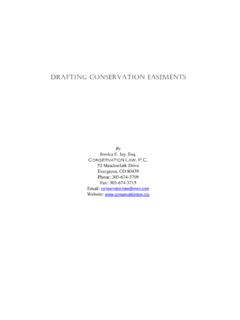Transcription of VALUATION - sherwood.support
1 38 Right of Way NOVEMBER/DECEMBER 2014 Appraisers are often tasked with evaluating easement rights being acquired and determining the impact on the remainder property. Since real estate exists in a marketplace that characteristically has many variables, an easement may be just one of many factors that affect a property s to the Dictionary of Real Estate Appraisal, an easement is an interest in real property that conveys use, but not ownership, of a portion of an owner s property. By definition, the ownership of real estate is endowed with a bundle of rights.
2 The bundle of rights concept maintains that like a bundle of sticks, real property ownership may be wholly intact (fee simple estate) or may be unbundled and conveyed in part to a third property owner has the inherent right to use the property, sell it, lease it, enter it, give it away, or even refuse to do any of these things. For example, the creation of a lease conveys to the tenant a portion of the owner s rights for the specific term and space occupied by the tenant according to the lease terms. During the lease period, the tenant may have a measurable interest in the property.
3 The creation of an easement is somewhat similar to a lease in that both are dealing with the concepts of time and space. By definition, the creation of an easement conveys a portion of the total bundle of rights to a third party. The challenge before the appraiser is the measurement in terms of dollars of the market value of the rights of EasementsWith respect to time, easements may be permanent or temporary in nature, with either specific or indefinite time frames. Temporary construction easements are fairly common and will terminate at either a specific time or at the end of construction and restoration.
4 In pipeline or other linear type projects, there may be a permanent easement, but it is usually not of sufficient width to accommodate material or equipment for the actual construction. In such a case, the creation of a temporary construction easement may be necessary. With permanent easements , these are perpetual and therefore have a permanent effect on the title of the property regardless of whether there are future owners until the termination of the easement or abandonment. Since the rules regarding the ending of a permanent easement may vary by jurisdiction, legal counsel should be DONNIE SHERWOOD, SR/WA, MAI, FRICSA reference guide to establishing the impact on the remainderVALUATION THEOF EASEMENTSNOVEMBER/DECEMBER 2014 Right of Way 39In terms of space, three broad classes of easements exist surface, sub-surface and overhead.
5 Subsurface easements may be required for the construction of water and sewer lines, petroleum pipelines, communication lines or tunnels. During construction, surface disturbance may occur and some above ground appurtenances may be present, however, the bulk of the project will remain below the surface and largely unseen. Common surface easements may allow for drainage, flowage, access, railroads and highways. These types of easements generally have a larger impact on the property s surface area. Typical overhead easements include electrical transmission lines or avigation easements .
6 easements may involve a combination of two or even all three types of space. For example, an overhead transmission line may require a surface area for the placement of a tower or pole structure. Some subsurface easements may require surface space for valves or metering stations. Thus, while generally classified as one of the three broad classes of easements , most easements involve multi-space and MethodologiesThe task before the appraiser is to evaluate the rights conveyed by the creation of the easement and to properly measure these rights.
7 The principles and methodology applied to appraising property for partial acquisitions also apply to the VALUATION of easements . All easement valuations are partial acquisitions under the theory that the property owner retains some residual rights within the easement area. The value of an easement is measured by what the property owner has lost from the bundle of rights, not by what the grantee has before and after methodology (also known as the federal method) is the appraisal procedure cited in the Yellow Book and used in federal acquisitions as well as by some states.
8 The value of the easement is based on the difference between the value of the whole property before the taking and its value after the taking with the easement in place. In the following example, the $60,000 in total compensation includes both the value of the easement rights being acquired and any damages to the remainder property that may result due to the placement of the easement. Under this method, if the remainder after value shows an enhancement or benefit, it can result in zero dollars in compensation. The summation method has been adopted by many states and will indicate the same compensation value as the before and after methodology, except where benefits are present in the remainder property after the acquisition.
9 Using this method, benefits can offset damages, but the landowner is always entitled to the value of the part acquired. In easement acquisitions, rarely would one encounter situations where there are benefits. Thus, both methods will indicate the same opinion of compensation. Using this approach, the appraiser will be required to estimate the value of the easement plus damages to the remainder, if any. For example:The challenge for the appraiser is ascertaining where these figures come from. The answer is the market! The appraiser s task is to see what effect, if any, an easement has on the sale of property encumbered with similar easements .
10 In the case of residential property, most urban properties within platted subdivisions are likely encumbered with common utility easements . In most situations, these easements extend along the property line and have little effect, if any, on the sale of the home. Thus, the market tells us that the easement has little value, if any. This is because the presence of the easement does not affect the use or utility of the property and does not place any undue burden or hardship on the property support an opinion of compensation, appraisers often use matched pair sales analysis.






